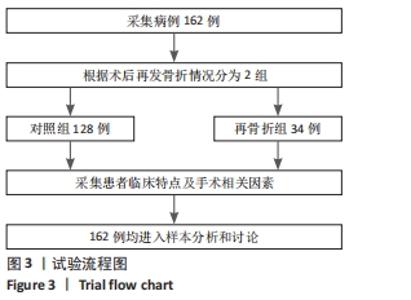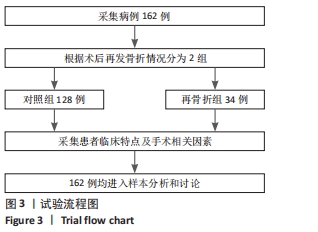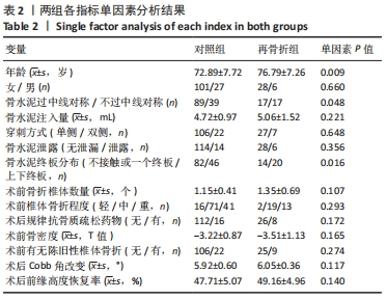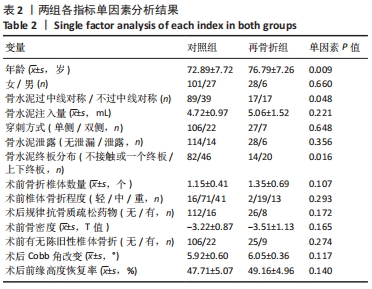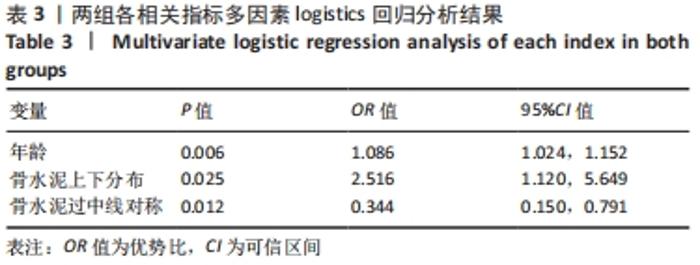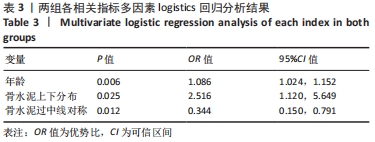Chinese Journal of Tissue Engineering Research ›› 2022, Vol. 26 ›› Issue (28): 4507-4513.doi: 10.12307/2022.306
Previous Articles Next Articles
Risk factors of recurrent fracture after injection of calcium phosphate cement in kyphoplasty: advanced age and stress change
Li Yang, Du Yibin, Liu Yiming, Li Fanjie
- Department of Spine Surgery, Third Affiliated Hospital of Anhui Medical University, Hefei 230061, Anhui Province, China
-
Received:2021-02-06Accepted:2021-03-24Online:2022-10-08Published:2022-03-18 -
Contact:Du Yibin, Chief physician, Department of Spine Surgery, Third Affiliated Hospital of Anhui Medical University, Hefei 230061, Anhui Province, China -
About author:Li Yang, Master candidate, Physician, Department of Spine Surgery, Third Affiliated Hospital of Anhui Medical University, Hefei 230061, Anhui Province, China -
Supported by:Applied Medicine Research Project of Health Commission of Hefei, No. 2019001(to DYB)
CLC Number:
Cite this article
Li Yang, Du Yibin, Liu Yiming, Li Fanjie. Risk factors of recurrent fracture after injection of calcium phosphate cement in kyphoplasty: advanced age and stress change[J]. Chinese Journal of Tissue Engineering Research, 2022, 26(28): 4507-4513.
share this article
Add to citation manager EndNote|Reference Manager|ProCite|BibTeX|RefWorks
| [1] LIU J, TANG J, ZHANG Y, et al. Percutaneous Vertebral Augmentation for Osteoporotic Vertebral Compression Fracture in the Midthoracic Vertebrae (T5-8): A Retrospective Study of 101 Patients with 111 Fractured Segments. World Neurosurg. 2019;122:e1381-e1387. [2] POURTAHERI S, LUO W, CUI C, et al. Vertebral Augmentation is Superior to Nonoperative Care at Reducing Lower Back Pain for Symptomatic Osteoporotic Compression Fractures: A Meta-Analysis. Clin Spine Surg. 2018;31(8):339-344. [3] MAZZANTINI M, FIGLIOMENI A, BOTTAI V, et al. High rate of vertebral refracture after vertebroplasty in patients taking glucocorticoids: a prospective two-year study. Clin Exp Rheumatol. 2020;38(4):649-653. [4] WANG WF, LIN CW, XIE CN, et al. The association between sarcopenia and osteoporotic vertebral compression refractures. Osteoporos Int. 2019;30(12):2459-2467. [5] 贾小林,谭祖键,杨阜滨,等.磷酸钙骨水泥与传统骨水泥后凸成形术治疗骨质疏松性椎体骨折的比较[J].中国骨与关节杂志, 2016,5(5):391-394. [6] RHO YJ, CHOE WJ, CHUN YI. Risk factors predicting the new symptomatic vertebral compression fractures after percutaneous vertebroplasty or kyphoplasty. Eur Spine J. 2012;21(5):905-911. [7] LIU H, ZHANG J, LIANG X, et al. Distribution Pattern Making Sense: Patients Achieve Rapider Pain Relief with Confluent Rather Than Separated Bilateral Cement in Percutaneous Kyphoplasty for Osteoporotic Vertebral Compression Fractures. World Neurosurg. 2019;126:e1190-e1196. [8] SUN HB, JING XS, LIU YZ, et al. The Optimal Volume Fraction in Percutaneous Vertebroplasty Evaluated by Pain Relief, Cement Dispersion, and Cement Leakage: A Prospective Cohort Study of 130 Patients with Painful Osteoporotic Vertebral Compression Fracture in the Thoracolumbar Vertebra. World Neurosurg. 2018; 114:e677-e688. [9] YU W, LIANG D, YAO Z, et al. Risk factors for recollapse of the augmented vertebrae after percutaneous vertebroplasty for osteoporotic vertebral fractures with intravertebral vacuum cleft. Medicine (Baltimore). 2017;96(2):e5675. [10] KOLANU N, SILVERSTONE EJ, HO BH, et al. Clinical Utility of Computer-Aided Diagnosis of Vertebral Fractures From Computed Tomography Images. J Bone Miner Res. 2020;35(12):2307-2312. [11] LI Y, YAN L, CAI S, et al. The prevalence and under-diagnosis of vertebral fractures on chest radiograph. BMC Musculoskelet Disord. 2018;19(1): 235. [12] JAEBLON T. Polymethylmethacrylate: properties and contemporary uses in orthopaedics. J Am Acad Orthop Surg. 2010;18(5):297-305. [13] PATEL H, CM RK, AA P, et al. The Effect of Primer on Bond Strength of Silicone Prosthetic Elastomer to Polymethylmethacrylate: An in vitro Study. J Clin Diagn Res. 2015;9(3):ZC38-ZC42. [14] 杨中华,崔青,魏华,等.经皮椎体成形术磷酸钙骨水泥治疗老年骨质疏松性椎体压缩性骨折[J].中国骨质疏松杂志,2010,16(6): 439-441. [15] HU L, SUN H, WANG H, et al. Cement injection and postoperative vertebral fractures during vertebroplasty. J Orthop Surg Res. 2019; 14(1):228. [16] KIM YY, RHYU KW. Recompression of vertebral body after balloon kyphoplasty for osteoporotic vertebral compression fracture. Eur Spine J. 2010;19(11):1907-1912. [17] ZHU J, ZHANG K, LUO K, et al. Mineralized Collagen Modified Polymethyl Methacrylate Bone Cement for Osteoporotic Compression Vertebral Fracture at 1-Year Follow-up. Spine(Phila Pa 1976). 2019; 44(12):827-838. [18] DENG D, LIAN Z, CUI W, et al. Function of low back muscle exercise: Preventive effect of refracture analysis of postoperative vertebral fractures. Orthopade. 2019;48(4):337-342. [19] ZHANG J, FAN Y, HE X, et al. Bracing after percutaneous vertebroplasty for thoracolumbar osteoporotic vertebral compression fractures was not effective. Clin Interv Aging. 2019;14:265-270. [20] HUANG ZF, XIA P, LIU K, et al. Analysis of Risk Factors of New Fracture of Vertebral Body After Percutaneous Kyphoplasty in Patients with Primary Osteoporotic Fracture of Thoracic and Lumbar Spine. J Biomater Tiss Eng. 2018,8(5):756-759. [21] LUO J, ANNESLEY-WILLIAMS DJ, ADAMS MA, et al. How are adjacent spinal levels affected by vertebral fracture and by vertebroplasty? A biomechanical study on cadaveric spines. Spine J. 2017;17(6):863-874. [22] XIE L, ZHAO ZG, ZHANG SJ, et al. Percutaneous vertebroplasty versus conservative treatment for osteoporotic vertebral compression fractures: An updated meta-analysis of prospective randomized controlled trials. Int J Surg. 2017;47:25-32. [23] PENG Y, DU X, HUANG L, et al. Optimizing bone cement stiffness for vertebroplasty through biomechanical effects analysis based on patient-specific three-dimensional finite element modeling. Med Biol Eng Comput. 2018;56(11):2137-2150. [24] ROTTER R, PFLUGMACHER R, KANDZIORA F, et al. Biomechanical in vitro testing of human osteoporotic lumbar vertebrae following prophylactic kyphoplasty with different candidate materials. Spine (Phila Pa 1976). 2007;32(13):1400-1405. [25] SIRIS ES, MILLER PD, BARRETT-CONNOR E, et al. Identification and fracture outcomes of undiagnosed low bone mineral density in postmenopausal women: results from the National Osteoporosis Risk Assessment. JAMA. 2001;286(22):2815-2822. [26] 黄天霁,寇玉辉,殷晓峰,等.椎体强化术后再发椎体骨折的临床特点和危险因素[J].北京大学学报(医学版),2015,47(2):237-241. [27] 黄何平,宁亮生,温志宏.跟骨骨密度及骨强度与运动的关系[J].中国组织工程研究与临床康复,2008,12(46):9134-9137. [28] TSENG YY, SU CH, LUI TN, et al. Prospective comparison of the therapeutic effect of teriparatide with that of combined vertebroplasty with antiresorptive agents for the treatment of new-onset adjacent vertebral compression fracture after percutaneous vertebroplasty. Osteoporos Int. 2012;23(5):1613-1622. [29] GERTZ BJ, CLEMENS JD, HOLLAND SD, et al. Application of a new serum assay for type I collagen cross-linked N-telopeptides: assessment of diurnal changes in bone turnover with and without alendronate treatment. Calcif Tissue Int. 1998;63(2):102-106. [30] CHEN CH, FAN P, XIE XH, et al. Risk Factors for Cement Leakage and Adjacent Vertebral Fractures in Kyphoplasty for Osteoporotic Vertebral Fractures. Clin Spine Surg. 2020;33(6):E251-E255. [31] YAMAUCHI K, ADACHI A, KAMEYAMA M, et al. A risk factor associated with subsequent new vertebral compression fracture after conservative therapy for patients with vertebral compression fracture: a retrospective observational study. Arch Osteoporos. 2020;15(1):9. [32] TAKAHASHI S, HOSHINO M, YASUDA H, et al. Development of a scoring system for predicting adjacent vertebral fracture after balloon kyphoplasty. Spine J. 2019;19(7):1194-1201. [33] ZHANG L, WANG Q, WANG L, et al. Bone cement distribution in the vertebral body affects chances of recompression after percutaneous vertebroplasty treatment in elderly patients with osteoporotic vertebral compression fractures. Clin Interv Aging. 2017;12:431-436. [34] XU K, LI YL, SONG F, et al. Influence of the distribution of bone cement along the fracture line on the curative effect of vertebral augmentation. J Int Med Res. 2019;47(9):4505-4513. [35] YU W, XU W, JIANG X, et al. Risk Factors for Recollapse of the Augmented Vertebrae After Percutaneous Vertebral Augmentation: A Systematic Review and Meta-Analysis. World Neurosurg. 2018;111: 119-129. [36] 张大鹏,毛克亚,强晓军,等.椎体增强术后骨水泥分布形态分型及其临床意义[J].中华创伤杂志,2018,34(2):130-137. [37] WANG DG, LI Y, YIN HL, et al. Three-dimensional finite element analysis of optimal distribution model of vertebroplasty. Ann Palliat Med. 2020; 9(3):1062-1072. [38] LI YX, MO GY, ZHANG SC, et al. Cement for Treating Osteoporotic Vertebral Compression Fractures: Finite Element Study and Clinical Outcomes. J Biomater Tiss eng. 2018;8(12):1652-1657. [39] BOGER A, HEINI P, WINDOLF M, et al. Adjacent vertebral failure after vertebroplasty: a biomechanical study of low-modulus PMMA cement. Eur Spine J. 2007;16(12):2118-2125. [40] STEINMANN J, TINGEY CT, CRUZ G, et al. Biomechanical comparison of unipedicular versus bipedicular kyphoplasty. Spine (Phila Pa 1976). 2005;30(2):201-205. [41] SUN HL, LI CD. Comparison of unilateral and bilateral percutaneous vertebroplasty for osteoporotic vertebral compression fractures: a systematic review and meta-analysis. J Orthop Surg Res. 2016;11(1): 156. [42] ZHU SQ, SU QJ, ZHANG YS, et al. Risk factors of cemented vertebral refracture after percutaneous vertebral augmentation: a systematic review and meta-analysis. Neuroradiology. 2020;62(11):1353-1360. |
| [1] | Cui Wei, Cui Di, Ouyang Ting, Li Xiang, Wei Huiting, Xue Weiyue, Zhou Gang, Qiu Ye. Inhibiting NOX alleviates alcoholic liver damage and lipid metabolism disorder [J]. Chinese Journal of Tissue Engineering Research, 2022, 26(在线): 1-8. |
| [2] | Zhu Chan, Han Xuke, Yao Chengjiao, Zhou Qian, Zhang Qiang, Chen Qiu. Human salivary components and osteoporosis/osteopenia [J]. Chinese Journal of Tissue Engineering Research, 2022, 26(9): 1439-1444. |
| [3] | Wei Guoqiang, Li Yunfeng, Wang Yi, Niu Xiaofen, Che Lifang, Wang Haiyan, Li Zhijun, Shi Guopeng, Bai Ling, Mo Kai, Zhang Chenchen, Xu Yangyang, Li Xiaohe. Biomechanical analysis of non-uniform material femur under different loads [J]. Chinese Journal of Tissue Engineering Research, 2022, 26(9): 1318-1322. |
| [4] | Jiang Huanchang, Zhang Zhaofei, Liang De, Jiang Xiaobing, Yang Xiaodong, Liu Zhixiang. Comparison of advantages between unilateral multidirectional curved and straight vertebroplasty in the treatment of thoracolumbar osteoporotic vertebral compression fracture [J]. Chinese Journal of Tissue Engineering Research, 2022, 26(9): 1407-1411. |
| [5] | Yu Chengxiang, Liu Lehong, Li Wenbo, Chen Jinshi, Ran Chunlei, Wang Zhongping. Correlation between spine-pelvic sagittal parameters and prognosis of vertebroplasty in the treatment of thoracolumbar osteoporotic vertebral compression fractures [J]. Chinese Journal of Tissue Engineering Research, 2022, 26(9): 1412-1417. |
| [6] | Li Wei, Zhu Hanmin, Wang Xin, Gao Xue, Cui Jing, Liu Yuxin, Huang Shuming. Effect of Zuogui Wan on bone morphogenetic protein 2 signaling pathway in ovariectomized osteoporosis mice [J]. Chinese Journal of Tissue Engineering Research, 2022, 26(8): 1173-1179. |
| [7] | Xiao Hao, Liu Jing, Zhou Jun. Research progress of pulsed electromagnetic field in the treatment of postmenopausal osteoporosis [J]. Chinese Journal of Tissue Engineering Research, 2022, 26(8): 1266-1271. |
| [8] | Gao Yujin, Peng Shuanglin, Ma Zhichao, Lu Shi, Cao Huayue, Wang Lang, Xiao Jingang. Osteogenic ability of adipose stem cells in diabetic osteoporosis mice [J]. Chinese Journal of Tissue Engineering Research, 2022, 26(7): 999-1004. |
| [9] | Wang Hailong, Li Long, Maihemuti·Yakufu, Chen Hongtao, Liu Xu, Yilihamu·Tuoheti. Finite element analysis of stress distribution of acetabular prosthesis in the Lewinnek safety zone [J]. Chinese Journal of Tissue Engineering Research, 2022, 26(6): 843-847. |
| [10] | Li Shuo, Su Peng, Zhang Li, Wu Qiulong, Hu Xiangyu, Lai Yuliang. Positive effect of supracondylar femoral osteotomy on the correction of knee varus based on three-dimensional reconstruction and finite element analysis [J]. Chinese Journal of Tissue Engineering Research, 2022, 26(6): 858-863. |
| [11] | Liu Yuhang, Zhou Jianqiang, Xu Xuebin, Qu Xingyue, Li Ziyu, Li Kun, Wang Xing, Li Zhijun, Li Xiaohe, Zhang Shaojie. Establishment and validation of finite element model of lower cervical spine in 6-year-old children [J]. Chinese Journal of Tissue Engineering Research, 2022, 26(6): 870-874. |
| [12] | Guo Xiaohui, Song Xizheng, Xiang Hanrui, Kang Zhaorong, Li Daming, Kang Yu, Hu Jun, Sheng Kai. External spinal fixation elastic stress in the treatment of jumping spinal fracture [J]. Chinese Journal of Tissue Engineering Research, 2022, 26(6): 919-923. |
| [13] | Peng Kun. Improvement of the treatment effect of osteoporotic fractures: research status and strategy analysis [J]. Chinese Journal of Tissue Engineering Research, 2022, 26(6): 980-984. |
| [14] | Shen Song, Xu Bin. Diffuse distribution of bone cement in percutaneous vertebroplasty reduces the incidence of refracture of adjacent vertebral bodies [J]. Chinese Journal of Tissue Engineering Research, 2022, 26(4): 499-503. |
| [15] | Hou Wanxing, Li Hongwei, Zheng Xin, Zhu Xianren. Correlation between preoperative magnetic resonance imaging findings and bone cement leakage after percutaneous vertebral augmentation [J]. Chinese Journal of Tissue Engineering Research, 2022, 26(4): 504-509. |
| Viewed | ||||||
|
Full text |
|
|||||
|
Abstract |
|
|||||
